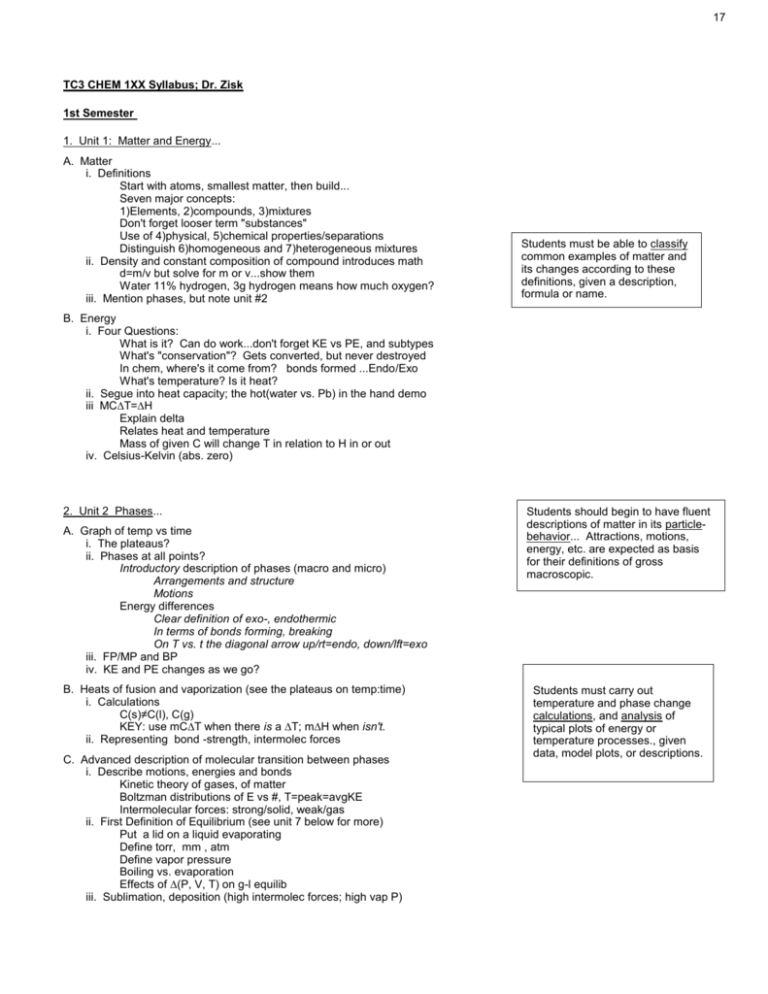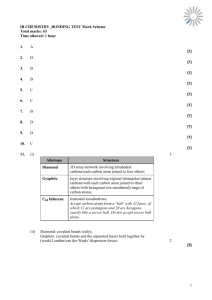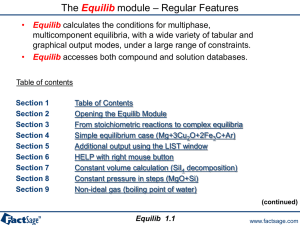ChTC3Outline
advertisement

17 TC3 CHEM 1XX Syllabus; Dr. Zisk 1st Semester 1. Unit 1: Matter and Energy... A. Matter i. Definitions Start with atoms, smallest matter, then build... Seven major concepts: 1)Elements, 2)compounds, 3)mixtures Don't forget looser term "substances" Use of 4)physical, 5)chemical properties/separations Distinguish 6)homogeneous and 7)heterogeneous mixtures ii. Density and constant composition of compound introduces math d=m/v but solve for m or v...show them Water 11% hydrogen, 3g hydrogen means how much oxygen? iii. Mention phases, but note unit #2 Students must be able to classify common examples of matter and its changes according to these definitions, given a description, formula or name. B. Energy i. Four Questions: What is it? Can do work...don't forget KE vs PE, and subtypes What's "conservation"? Gets converted, but never destroyed In chem, where's it come from? bonds formed ...Endo/Exo What's temperature? Is it heat? ii. Segue into heat capacity; the hot(water vs. Pb) in the hand demo iii MC∆T=∆H Explain delta Relates heat and temperature Mass of given C will change T in relation to H in or out iv. Celsius-Kelvin (abs. zero) 2. Unit 2 Phases... A. Graph of temp vs time i. The plateaus? ii. Phases at all points? Introductory description of phases (macro and micro) Arrangements and structure Motions Energy differences Clear definition of exo-, endothermic In terms of bonds forming, breaking On T vs. t the diagonal arrow up/rt=endo, down/lft=exo iii. FP/MP and BP iv. KE and PE changes as we go? B. Heats of fusion and vaporization (see the plateaus on temp:time) i. Calculations C(s)≠C(l), C(g) KEY: use mC∆T when there is a ∆T; m∆H when isn't. ii. Representing bond -strength, intermolec forces C. Advanced description of molecular transition between phases i. Describe motions, energies and bonds Kinetic theory of gases, of matter Boltzman distributions of E vs #, T=peak=avgKE Intermolecular forces: strong/solid, weak/gas ii. First Definition of Equilibrium (see unit 7 below for more) Put a lid on a liquid evaporating Define torr, mm , atm Define vapor pressure Boiling vs. evaporation Effects of ∆(P, V, T) on g-l equilib iii. Sublimation, deposition (high intermolec forces; high vap P) Students should begin to have fluent descriptions of matter in its particlebehavior... Attractions, motions, energy, etc. are expected as basis for their definitions of gross macroscopic. Students must carry out temperature and phase change calculations, and analysis of typical plots of energy or temperature processes., given data, model plots, or descriptions. 27 iv. Phase diagram3. Unit 3: Gas laws... A. Start with a balloon for all of these i. Sealed, so no change in amount of gas ii. Students can discover the inverse relat of P to V iii. The laws can be summarized What's a constant...what's it mean? PV and V/T stay at a constant level Try P1V1=P2V2 etc. B. Now leave the balloon and do the math implied above; C. Then move back to microscopic, Kin Theor Connection between matter-asparticles and the gas laws is critical: Students must really "get" that any ideal gas has the same molar volume-- Hence descriptive mastery, and distinction of ideal from nonideal, and calculating partial P and molar V, are all tested i. What's really happening in the vessel with ∆(P, V, T)? ii. Brackets with dots, compress 'em iii. Non-ideality at the extreme compression iv. Non-ideality with extreme cold D. Look at two-colored set of dots=two gases in mixture i. Talk about "exerting" pressure, impacts of dots ii. Each dot contributing a fraction of the total E. Ultimately, they must master (mole fract)x(total P)=(partial P) and (sum of partials)=(total) G. Also, Avagadro/Dalton give us 22.4L=1mole; 1mole=6x10 23 Unit 4: Atomic structure & e-config... A. Follow the paradigms-i. Democritus-- smallest particle; ii. Charge and the atom; Rutherford and arrangement iii. Einstein; Planck; Bohr; Schroedinger/Heisenberg iv. Summarize the current cloudy paradigm B. Construct a table of parts showing name, mass, charge, size. C. Symbols for elements are the key to parts: i. A, Z, and ion charge tell p's, n's and e's (not in that order) ii. What's ion?! We haven't defined electron movement!!... Shortly, not now... iii. Isotopes D. Most important: Electrons around a nucleus i. Shells, or "levels" ii. Movement between levels Students graph me climbing on chairs, desks, cabinets etc. No in-between places; energy release upon falling, absorb to climb Hence the image of quantized transitions, the Bohr Model iii. E=hƒ; ƒ=c/w; are they comfortable yet with powers of ten? iv. Radiation; spectra; fingerprints continuous vs. discrete bright-line vs absorption again, E=hƒ E. E-config In Total...recall/compare to Bohr model i. Energy level=shell; s-p-d=subshells; arrows are orbitals. ii. How many subshells, orbitals, electrons per energy level? iii. Defining the variations in sub-shells iv. Defining the ordering of energy of orbitals v. Filling rules; the "discrepancies" at d and f, and at half-filled- and filled-minus-one vi. Configuration notations and meaning; excited states notations vii. Filling order; config given Z? viii. Quantum numbers (treat this lightly) F. Nuclei again, get ready for the next unit: i. recall Z, p's and n's; ii. Let's define amu, gaw, gmw; iii. Look at that mole now. vi. practical uses medicinal After this unit, students must be able to determine any of these-- config, shell, subshell, number of electrons, next orbital, excited state, transition energy, etc.-given an element or partial description. 37 reactorsUnit 5: Bonding; Chemical Formulas at first glance ... Identify or construct reaction, A. Bonds structure or formula; name; i. Recall: Electrons interacting with each other explain driving force; explain why would nuclei come together? major chem/phys characteristics. electrostatics shared e's vs ions ii. Look again at Energy ∆H vs Rxn Coordinate-- what's happening here?? Bonding or any chemical∆ is always accompanied by energy∆ Cf units on Kinetics/Equilib and on ElectroChem: Chem doesWork Know each point on Foreshadow the Reverse/Forward DG-driven equilib we'll see later ∆H vs rxn-coord plot… iii. And we need a formalism: Using Lewis dot diagrams iv. These are, broadly put, valence electrons-- but we'd better definehybridization Allows VSEPR model Multiple bonding Expanded octets v. Molecular structure Explain all forms of intra/inter General structures (refer back to bonding) bonding and attractions for Molecular dipole; symmetry; range from ionic to VanderWaals typical compounds. Role of lone pairs...coordinate covalent bonds vi. The unusual cases: metallic networks B. Formulas i. Charge-ox.state summing, balancing ii. Names and endings iii. Polyatomic ions Names=formulas using simple and Stock. Unit 6: Periodic Table ... A. What's happening to atomic structure across periods or down groups? B Periodic trends i. EN, IP, r ii. Activity (vs. "reactivity) iii. Ox numbers and valence electrons revisited, with the table as a map C. The Major Groups i. Alkali; alkaline earth; ii. Transition; sub-transition metals; iii. Metalloids; iv. Halogens; noble gases Students deduce any part of the table from description of characteristics and vice versa; and explain why using structure vs position on table. 2nd Semester Unit 7: Chemical Formulas and Equations in some detail... A. Quantities of interest Moles; gaw/gaw/aw/fw; amu; M/m Formulas imply these quantities B. Mass balanced equations C. Concentrations; distinct from Ideal Gas Molar Volume conversions D. Real quantitative problems Molecular mass and density of ideal gases Percent composition Composition and empirical-molecular formulas Chemical equations and (mass-volume-concentration-number) problems Diffusion, mass and Graham's Law Unit 8: Kinetics and Equilibrium; Solutions and Solubility... A. Defining dynamic equilibrium Evaporation in a closed container Saturated solutions with ppt interface Rates and factor governing them B. Equilibrium constants and LeChatelier Solve typical calc's. Explain meaning of units. Describe what's happening in reaction. 47 Steady conc's, but still dynamic; rate(f)=rate(r); T effects Addition to system with inherent constant forces change But define in terms of stress or kinetics for true depiction C. Solution behavior is nice image of kinetics and equilib Solvation Attractions Enthalpy and Entropy as Driving Forces D. Gibbs Free Energy, Defined and Equation To do work Students will put Gibbs terms into chem/phys descriptions, and accessible metaphors or models; assess spontaneity; predict stress effects; pictorially depict processes Spontaneity Energy vs reaction progress curves, again Dominant terms in various cases for the equation . Unit 9: More on Solutions;special cases of Acids and Bases... A. Dissolving vs dissociation-- is it clear B. Electrolyte behavior What is conductivity? How ions behave, considering metals, fused salts and electrolytic solutions C. Dissociation in water, and of water itself D. Define acids and question the utility, history of each model Arrhenius Bronsted/Lowry Lewis E. Conjugate acid-base pairs Reactions; can they find the species of interest? Strength; conjugate of strong is weak and vice verse Amphoterics Using tables or K, tell acids, bases, strength, product; neutralization V, M and pH calc's F. Acid or base equilibrium constants How's their exponential and logarithmic math? Significance of the product, in water, in syntheses, and in biological systems Defining autodissoc constant for water, pH/pOH G. Titrations and other real quantitative problems Unit 10: RedOx and Electrochemistry Just another equilibrium, another driving force… A. One species oxidizes another; and is in turn reduced B. Changes in oxidation state Element cries to a buddy "I've been robbed, someone stole my electron". Reply "are you sure". Element says "yeah, I'm positive" C. Look at a whole redox reaction first Follow the changes Look at electron flow It's two halves of a battery D. Using an activity series All are given in the series as reductions, as the cathode reaction Defining stronger/weaker reduction potentials as voltages; ∆G=-nFE The weaker half reaction, lower on the series, must proceed as ox E. Now set up two half-cells, and show a whole reaction as summed Where's voltage obtained, physically and mathematically? What does it mean to "balance" electrons gained/lost? G. What are the other parts of the cell?…Find the cathode/anode, and the signs H Electrolytic cells?? I. Finally, balancing given reactions, and exploring inherent voltage, current. Unit 11: Organic overview “Here’s where you’d go next year...” A. Carbon; life; SPONCH Bonding 57 General chem-phys characteristics B. Simplest compounds; homologous series C. Major groups: -anes/enes/ynes; -ols; -als; -ones; acids; esters; amines/amino-acids Easily confused sets... Distinguishing features What do they do, chemically-physically Tabulate the nomenclature D. Major reactions: sub; add; elim; dehydrate; sapon; combust; ferment; polymer; crack! Environmental issues? Unit 12: Industrial and other Chemical Applications we've mentioned,In Summary.. Haber; Catalyses Cracking; Syntheses Plating/batteries; Oxidations; corrosions/preventatives Metabolic pathways Nuclear reactors Discuss main features of given process; pick a process for a given purpose; explain practical significance of given process.






